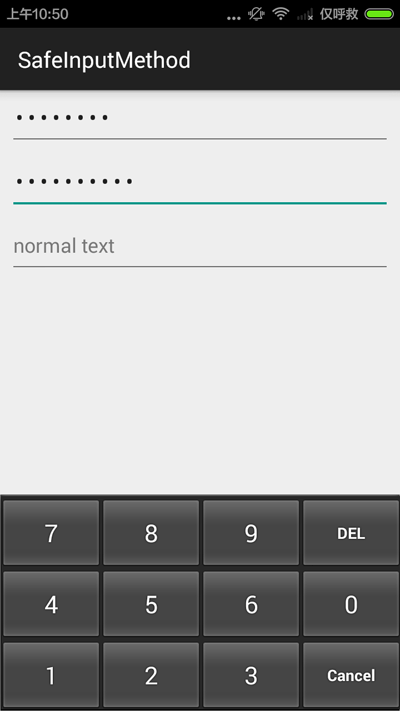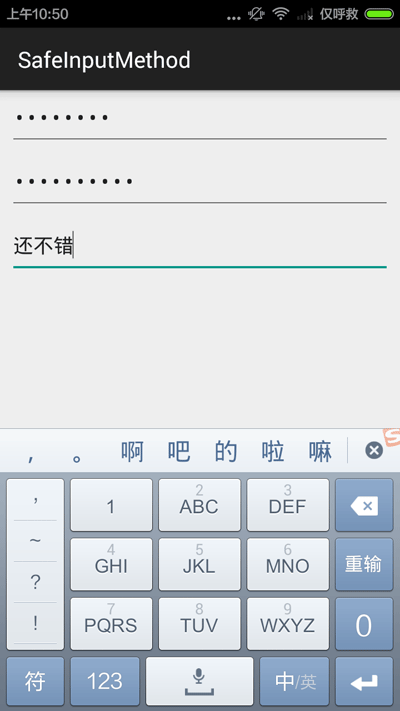Android编程实现自定义输入法功能示例【输入密码时防止第三方窃取】
发布于 2017-10-05 11:46:13 | 211 次阅读 | 评论: 0 | 来源: 网友投递
Android移动端操作系统
Android是一种基于Linux的自由及开放源代码的操作系统,主要使用于移动设备,如智能手机和平板电脑,由Google公司和开放手机联盟领导及开发。尚未有统一中文名称,中国大陆地区较多人使用“安卓”或“安致”。
这篇文章主要介绍了Android编程实现自定义输入法功能,可实习输入密码时防止第三方窃取的效果,结合实例形式详细分析了Android布局、控件及输入法相关操作技巧,需要的朋友可以参考下
本文实例讲述了Android编程实现自定义输入法功能。分享给大家供大家参考,具体如下:
对于Android用户而言,一般都会使用第三方的输入法。可是,在输入密码时(尤其是支付相关的密码),使用第三方输入法有极大的安全隐患。目前很多网银类的APP和支付宝等软件在用户输入密码时,都会弹出自定义的输入法而不是直接使用系统输入法。
这里介绍的就是如何实现一个简单的自定义输入法。当然,也可以自己写一个Dialog加上几十个按钮让用户输入,只不过这样显得不够专业。
(一)首先上效果图:
1.前面两个输入框使用了自定义的输入法:

2.第三个输入框没有进行任何设置,因此将使用默认的输入法:

(二)代码简介:
1.主页面布局,由3个输入框加上一个android.inputmethodservice.KeyboardView组成。android.inputmethodservice.KeyboardView是一个系统自带的继承自View的组件,但是它不在android.view这个包下面,因此这里需要写上完整的包名。
<RelativeLayout xmlns:android="http://schemas.android.com/apk/res/android"
android:layout_width="match_parent"
android:layout_height="match_parent">
<!--前两个EditText均使用自定义的输入法-->
<EditText
android:id="@+id/input_password"
android:layout_width="match_parent"
android:layout_height="wrap_content"
android:layout_margin="8dp"
android:hint="one password"
android:layout_alignParentTop="true"
android:inputType="textPassword" />
<EditText
android:id="@+id/input_password2"
android:layout_width="match_parent"
android:layout_height="wrap_content"
android:layout_below="@+id/input_password"
android:layout_margin="8dp"
android:hint="another password"
android:inputType="textPassword" />
<!--这个EditText使用默认的输入法-->
<EditText
android:id="@+id/input_normal_text"
android:layout_width="match_parent"
android:layout_height="wrap_content"
android:layout_below="@+id/input_password2"
android:layout_margin="8dp"
android:hint="normal text" />
<android.inputmethodservice.KeyboardView
android:id="@+id/keyboardview"
android:layout_width="match_parent"
android:layout_height="wrap_content"
android:layout_alignParentBottom="true"
android:layout_centerHorizontal="true"
android:focusable="true"
android:focusableInTouchMode="true"
android:visibility="gone" />
</RelativeLayout>
2.KeyboardView是一个显示输入法的容器控件,使用时需要设置具体的输入法面板内容。
(1)首先在res下新建xml目录,然后创建文件keys_layout.xml,即输入法面板的内容。每个row表示一行,Keyboad的属性keyWidth和keyHeight表示每个按键的大小,25%p表示占父组件的25%. Key的属性codes表示该按键的编号(点击时系统回调方法中会返回这个值,用以区分不同的按键),keyLabel表示按键上面显示的文字。还有很多其它的属性,不再陈述。
<?xml version="1.0" encoding="utf-8"?>
<Keyboard xmlns:android="http://schemas.android.com/apk/res/android"
android:keyWidth="25%p"
android:keyHeight="10%p">
<Row>
<Key
android:codes="55"
android:keyLabel="7"
android:keyEdgeFlags="left" />
<Key
android:codes="56"
android:keyLabel="8" />
<Key
android:codes="57"
android:keyLabel="9" />
<!--删除按键长按时连续响应-->
<Key
android:codes="60001"
android:keyLabel="DEL"
android:isRepeatable="true" />
</Row>
<Row>
<Key
android:codes="52"
android:keyLabel="4"
android:keyEdgeFlags="left" />
<Key
android:codes="53"
android:keyLabel="5" />
<Key
android:codes="54"
android:keyLabel="6" />
<Key
android:codes="48"
android:keyLabel="0" />
</Row>
<Row>
<Key
android:codes="49"
android:keyLabel="1"
android:keyEdgeFlags="left" />
<Key
android:codes="50"
android:keyLabel="2" />
<Key
android:codes="51"
android:keyLabel="3" />
<Key
android:codes="60002"
android:keyLabel="Cancel" />
</Row>
</Keyboard>
(2)为了使用方便,新建一个类:KeyboardBuilder.java,用于初始化自定义输入法和绑定EditText,代码如下:
public class KeyboardBuilder {
private static final String TAG = "KeyboardBuilder";
private Activity mActivity;
private KeyboardView mKeyboardView;
public KeyboardBuilder(Activity ac, KeyboardView keyboardView, int keyBoardXmlResId) {
mActivity = ac;
mKeyboardView = keyboardView;
Keyboard mKeyboard = new Keyboard(mActivity, keyBoardXmlResId);
// Attach the keyboard to the view
mKeyboardView.setKeyboard(mKeyboard);
// Do not show the preview balloons
mKeyboardView.setPreviewEnabled(false);
KeyboardView.OnKeyboardActionListener keyboardListener = new KeyboardView.OnKeyboardActionListener() {
@Override
public void onKey(int primaryCode, int[] keyCodes) {
// Get the EditText and its Editable
View focusCurrent = mActivity.getWindow().getCurrentFocus();
if (focusCurrent == null || !(focusCurrent instanceof EditText)) {
return;
}
EditText edittext = (EditText) focusCurrent;
Editable editable = edittext.getText();
int start = edittext.getSelectionStart();
// Handle key
if (primaryCode == Constant.CodeCancel) {
hideCustomKeyboard();
} else if (primaryCode == Constant.CodeDelete) {
if (editable != null && start > 0) {
editable.delete(start - 1, start);
}
} else {
// Insert character
editable.insert(start, Character.toString((char) primaryCode));
}
}
@Override
public void onPress(int arg0) {
}
@Override
public void onRelease(int primaryCode) {
}
@Override
public void onText(CharSequence text) {
}
@Override
public void swipeDown() {
}
@Override
public void swipeLeft() {
}
@Override
public void swipeRight() {
}
@Override
public void swipeUp() {
}
};
mKeyboardView.setOnKeyboardActionListener(keyboardListener);
}
//绑定一个EditText
public void registerEditText(EditText editText) {
// Make the custom keyboard appear
editText.setOnFocusChangeListener(new View.OnFocusChangeListener() {
@Override
public void onFocusChange(View v, boolean hasFocus) {
if (hasFocus) {
showCustomKeyboard(v);
} else {
hideCustomKeyboard();
}
}
});
editText.setOnClickListener(new View.OnClickListener() {
@Override
public void onClick(View v) {
Log.d(TAG, "onClick");
showCustomKeyboard(v);
}
});
editText.setOnTouchListener(new View.OnTouchListener() {
@Override
public boolean onTouch(View v, MotionEvent event) {
Log.d(TAG, "onTouch");
EditText edittext = (EditText) v;
int inType = edittext.getInputType(); // Backup the input type
edittext.setInputType(InputType.TYPE_NULL); // Disable standard keyboard
edittext.onTouchEvent(event); // Call native handler
edittext.setInputType(inType); // Restore input type
edittext.setSelection(edittext.getText().length());
return true;
}
});
}
public void hideCustomKeyboard() {
mKeyboardView.setVisibility(View.GONE);
mKeyboardView.setEnabled(false);
}
public void showCustomKeyboard(View v) {
mKeyboardView.setVisibility(View.VISIBLE);
mKeyboardView.setEnabled(true);
if (v != null) {
((InputMethodManager) mActivity.getSystemService(Activity.INPUT_METHOD_SERVICE)).hideSoftInputFromWindow(v.getWindowToken(), 0);
}
}
public boolean isCustomKeyboardVisible() {
return mKeyboardView.getVisibility() == View.VISIBLE;
}
}
3.最后是主Activity的代码,这里就很简单了。
/**
* 自定义安全输入法
*/
public class MainActivity extends ActionBarActivity {
private KeyboardBuilder builder;
@Override
protected void onCreate(Bundle savedInstanceState) {
super.onCreate(savedInstanceState);
setContentView(R.layout.activity_main);
getWindow().setSoftInputMode(WindowManager.LayoutParams.SOFT_INPUT_STATE_ALWAYS_HIDDEN);
KeyboardView keyboardView = (KeyboardView) findViewById(R.id.keyboardview);
builder = new KeyboardBuilder(this, keyboardView, R.xml.keys_layout);
EditText editText = (EditText) findViewById(R.id.input_password);
builder.registerEditText(editText);
EditText editText2 = (EditText) findViewById(R.id.input_password2);
builder.registerEditText(editText2);
}
@Override
public void onBackPressed() {
if (builder != null && builder.isCustomKeyboardVisible()) {
builder.hideCustomKeyboard();
} else {
this.finish();
}
}
}
希望本文所述对大家Android程序设计有所帮助。